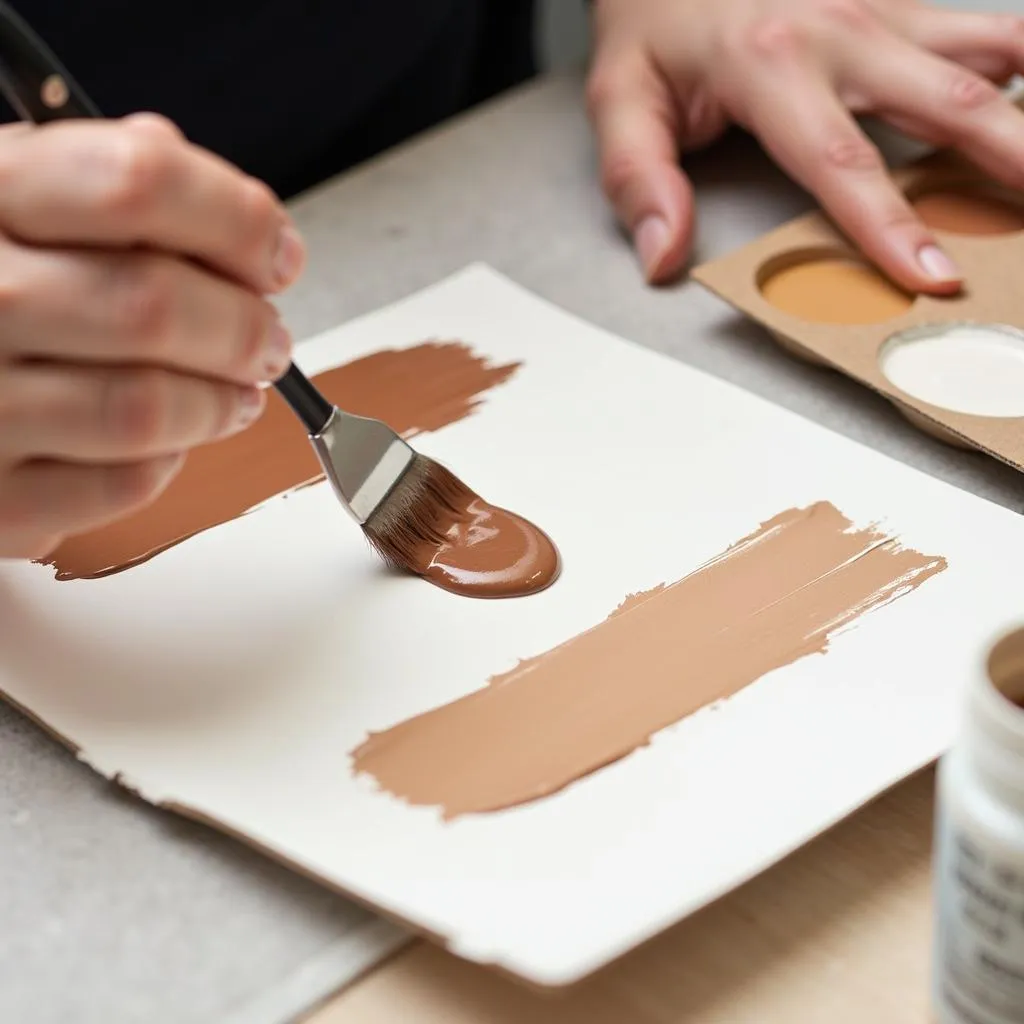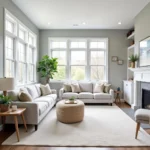Beige is a versatile and timeless color choice for interior walls, offering a warm and inviting ambiance to any room. Whether you’re aiming for a cozy and intimate atmosphere or a bright and airy feel, beige serves as an excellent neutral backdrop, allowing you to easily incorporate pops of color and personal style through furniture and decor.
While finding the perfect shade of beige pre-mixed at a paint store is possible, creating your own custom blend allows for greater control over the final hue, ensuring it perfectly complements your vision and the overall aesthetic of your space. In this comprehensive guide, we’ll delve into the art of mixing paint to achieve stunning beige tones, empowering you to transform your home with confidence and creativity.
Understanding the Color Wheel
Before embarking on your paint mixing journey, it’s crucial to grasp the fundamentals of color theory, particularly the relationships between colors on the color wheel. Beige, being a tertiary color, is created by combining two secondary colors, which in turn are derived from mixing primary colors.
To illustrate:
- Primary colors: Red, yellow, and blue form the foundation of the color wheel, and they cannot be created by mixing other colors.
- Secondary colors: Orange (red + yellow), green (blue + yellow), and violet (red + blue) are achieved by combining two primary colors.
- Tertiary colors: Beige, brown, and other nuanced hues are the result of mixing a primary color with an adjacent secondary color.
The Building Blocks of Beige
Beige is typically created by combining brown and white, with variations in shade and undertone achieved by adjusting the ratio of each color or incorporating small amounts of other hues. Here’s a breakdown of the key components:
- Brown: Forms the base of beige, providing depth and warmth. Different shades of brown, such as burnt umber, raw sienna, or burnt sienna, can be used to achieve varying levels of darkness and richness in the final beige.
- White: Lightens the brown, creating the characteristic pale tone of beige. Titanium white is a popular choice for its opacity and brightening effect.
- Yellow: Adds warmth and can create a sunny or buttery beige.
- Red: Introduces subtle warmth and can result in a pinkish or peachy beige.
- Blue: Cools down the warmth and can create a grayish or greige (gray-beige) hue.
Creating Your Custom Beige Paint
Now that you’re familiar with the color theory behind beige, let’s dive into the practical steps of mixing your own:
- Gather your materials: You’ll need brown and white paint, a mixing palette or container, a paint stirrer, and a few small containers for testing different ratios.
- Start with a small amount: Begin by squeezing a small amount of brown paint onto your palette.
- Gradually add white: Slowly incorporate white paint into the brown, stirring continuously to ensure a homogeneous mixture.
- Test as you go: After each addition of white, paint a small swatch on a piece of cardboard or paper to observe the developing color. Allow the swatch to dry completely, as paint colors tend to darken slightly as they dry.
- Adjust and refine: Depending on the desired shade and undertone, you can adjust the ratio of brown to white or introduce small amounts of other colors. For a warmer beige, add a touch of yellow or red. For a cooler beige, incorporate a hint of blue.
- Record your recipe: Once you’ve achieved your perfect beige, carefully note down the ratios of each color used. This will allow you to recreate the same shade consistently for future projects.
 Mixing paint for a custom beige color
Mixing paint for a custom beige color
Tips for Success:
- Lighting is key: Natural light is ideal for assessing paint colors, so try to mix your paint in a well-lit area or test your swatches against the wall in different lighting conditions throughout the day.
- Less is more: When adding additional colors to adjust the undertone, start with very small amounts and gradually increase until you achieve the desired effect. It’s easier to darken a color than to lighten it.
- Consider your surroundings: The existing colors in your room, such as flooring, furniture, and artwork, can influence how beige appears on your walls. Take these elements into account when selecting your shade and undertones.
Beige Beyond Walls
While beige is often associated with wall paint, its versatility extends far beyond. Consider incorporating this adaptable hue into other aspects of your home decor:
- Furniture: Beige sofas, armchairs, and ottomans provide a neutral foundation for colorful cushions and throws, creating a balanced and inviting seating area.
- Textiles: Beige curtains, rugs, and bedding introduce texture and warmth, softening the overall ambiance of a room.
- Decorative accents: Vases, lamps, and sculptures in beige tones add subtle sophistication and visual interest without overpowering the space.
 A living room decorated with warm beige tones
A living room decorated with warm beige tones
Conclusion:
Creating your own beige paint is a rewarding endeavor that allows you to achieve a truly custom color tailored to your unique style and space. By understanding the color wheel, the building blocks of beige, and following the step-by-step mixing process, you can confidently transform your home with this timeless and versatile hue.
Remember, experimentation is key. Don’t be afraid to play with different ratios and undertones until you discover the perfect shade of beige that brings your vision to life. For more inspiration on incorporating beige and other stunning colors into your home, explore our articles on what color walls go with blue carpet, what color goes with sage, and what color is pembroke.
FAQs
1. Can I use any type of brown paint to make beige?
While any brown paint can technically be used, certain shades lend themselves better to creating beige. Burnt umber, raw sienna, and burnt sienna are good starting points. Avoid browns that are overly cool or warm, as they can result in muddy or unexpected undertones.
2. What if my beige turns out too dark?
If your beige mixture is too dark, gradually add small amounts of white paint, stirring thoroughly between each addition, until you achieve the desired lightness.
3. How can I make a greige color?
To create a greige (gray-beige), start with your beige mixture and gradually incorporate small amounts of blue paint. The blue will counteract the warmth of the brown, resulting in a cool, sophisticated gray-beige hue.
4. Can I mix beige paint with leftover paint from other projects?
While it’s technically possible, it’s generally not recommended to mix leftover paints from different brands or batches. The chemical compositions can vary, potentially leading to undesirable reactions or inconsistent color results.
5. What’s the best finish for beige paint?
The best finish for your beige paint depends on the room and the desired look. Eggshell or satin finishes offer a subtle sheen and are suitable for most living areas. Matte finishes provide a velvety texture and are ideal for hiding imperfections.
Common Scenarios:
Scenario 1: You’re aiming for a warm and inviting living room with a cozy ambiance.
Recommendation: Opt for a beige with yellow or red undertones. Consider shades like “Honeycomb” or “Sandy Beach”.
Scenario 2: You want a sophisticated and calming bedroom with a spa-like atmosphere.
Recommendation: Choose a cool beige with gray or blue undertones. Explore shades like “Silver Sand” or “Stoney Creek”.
Scenario 3: You’re looking for a versatile neutral for a hallway that connects multiple rooms with different color palettes.
Recommendation: A balanced beige with subtle undertones works best for hallways. Consider shades like “Classic Khaki” or “Urban Putty”.
Explore More:
For further guidance on navigating the world of colors, explore our articles on what is color blush and what color is grayish green.
Need Help?
Contact us today! Phone number: 0373298888, email: SEO.backlink@gmail.com, or visit our store at 86 Cau Giay, Hanoi. Our dedicated customer support team is available 24/7 to assist you.

